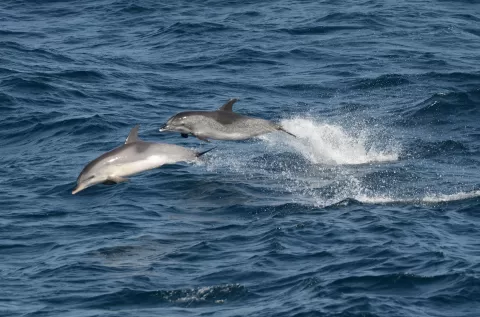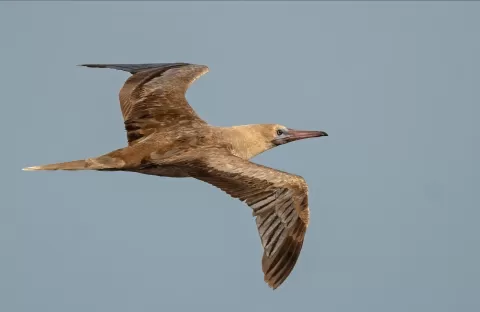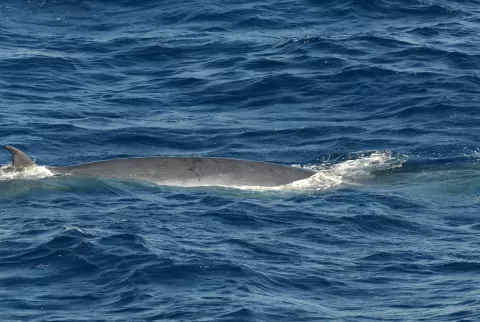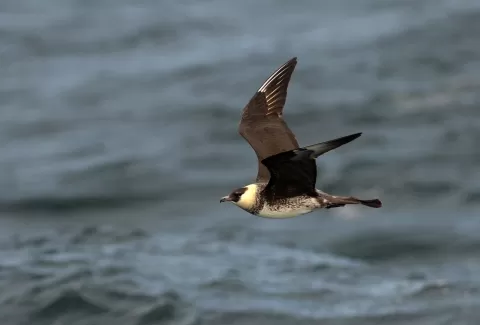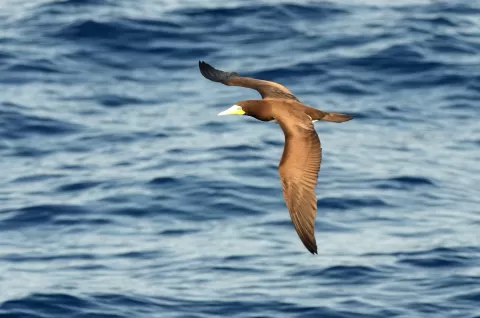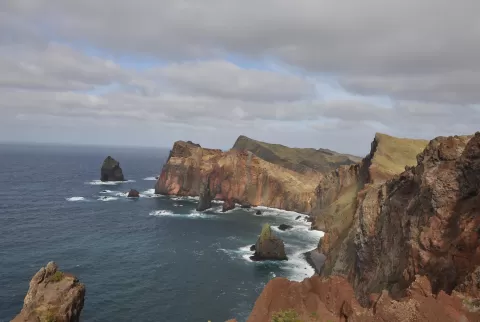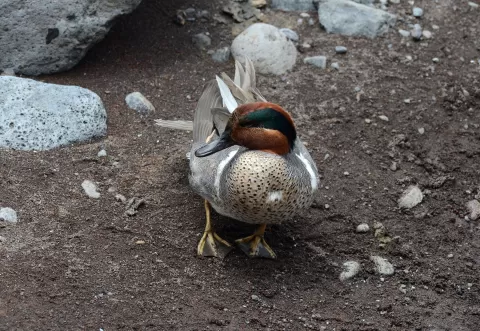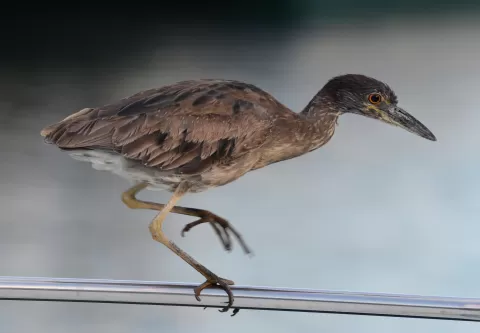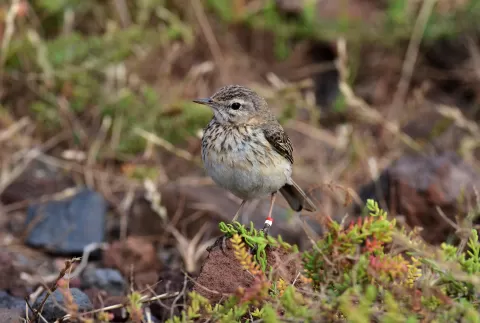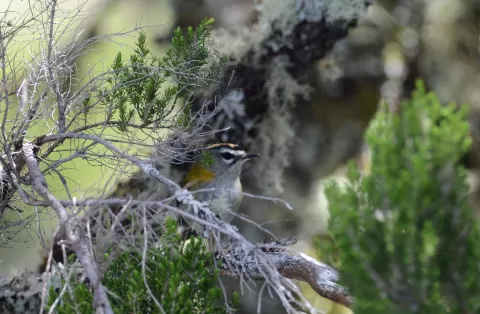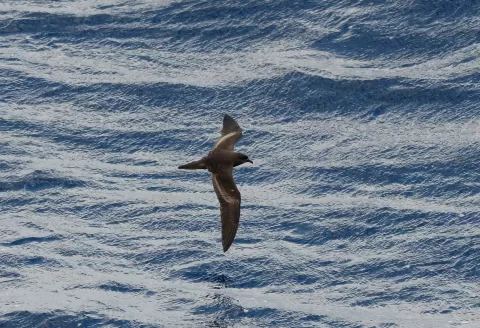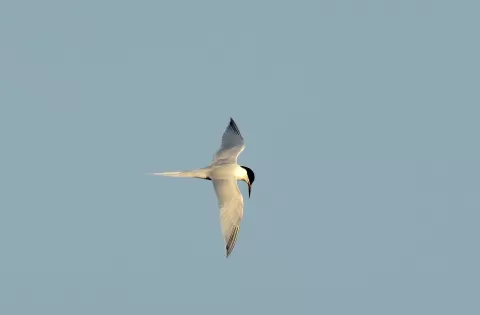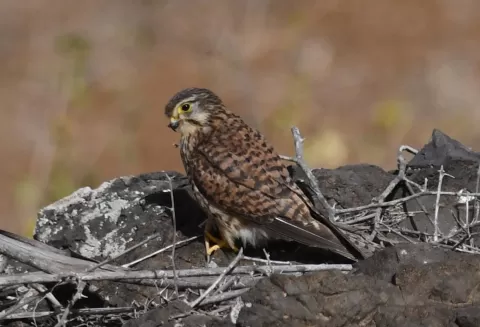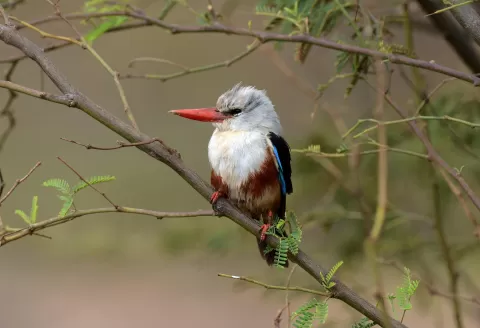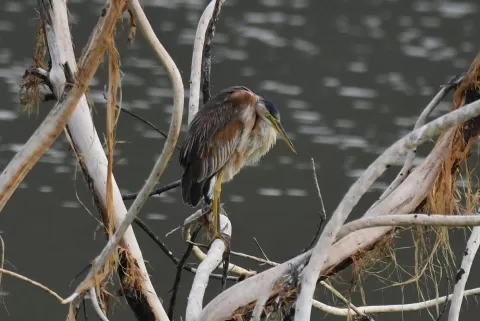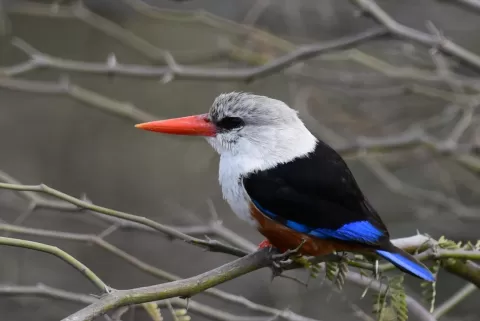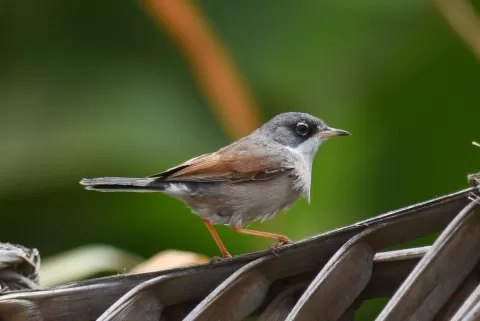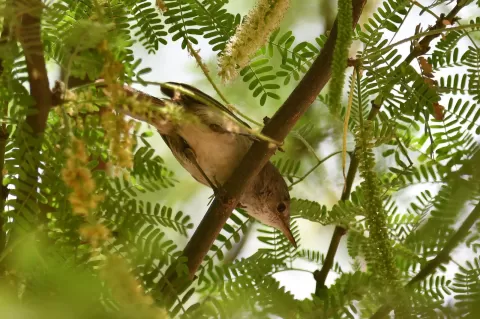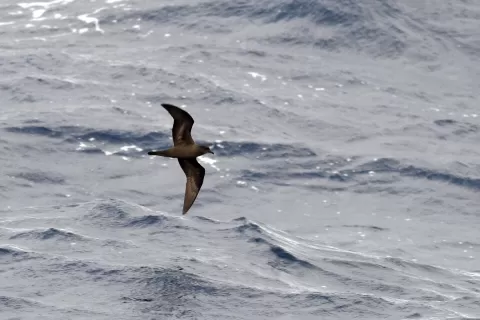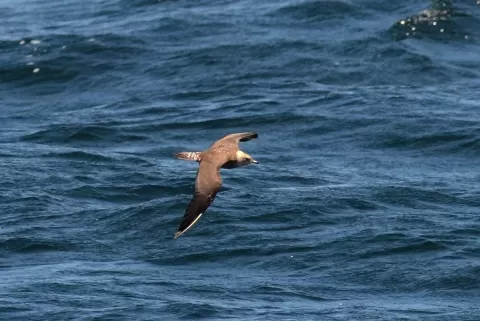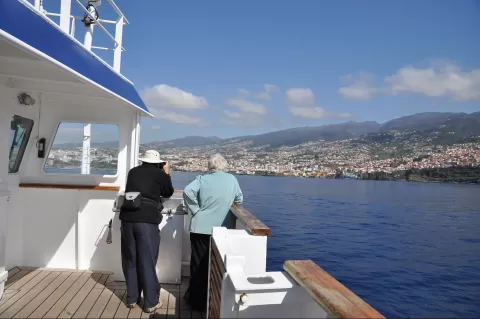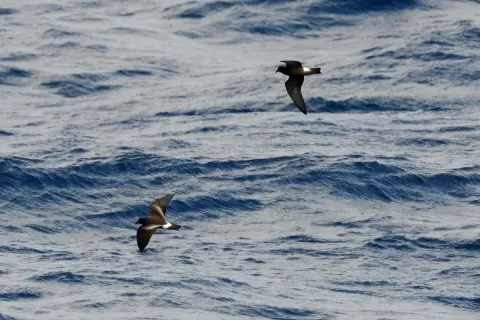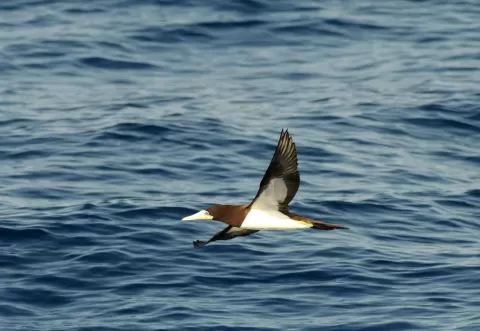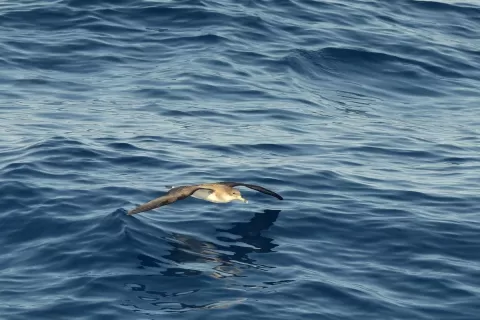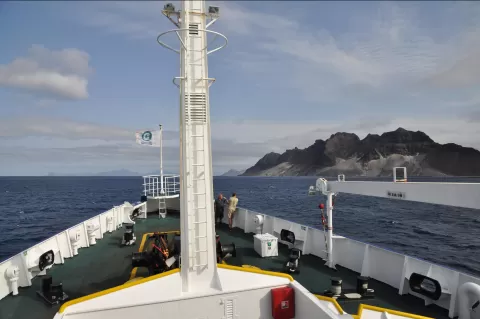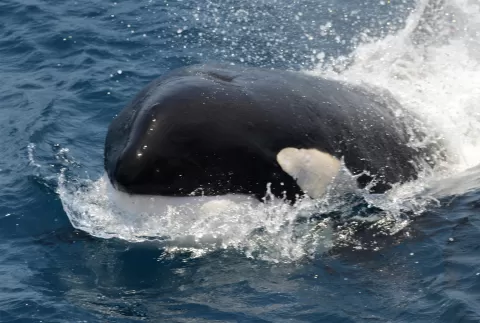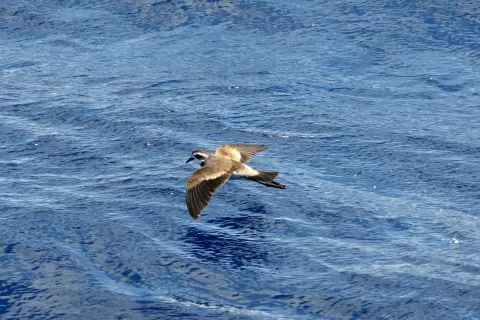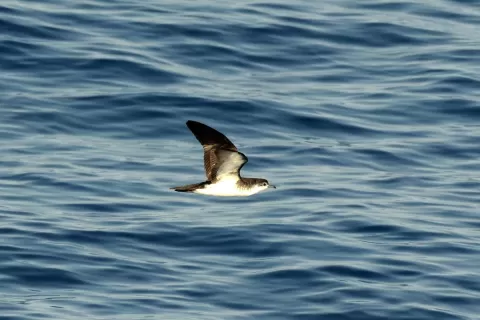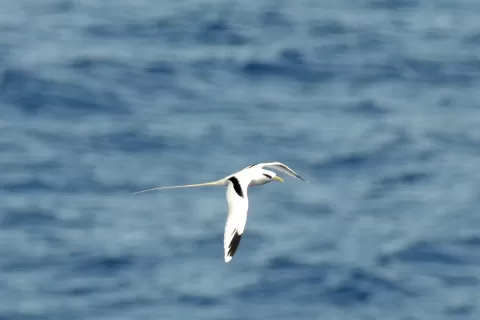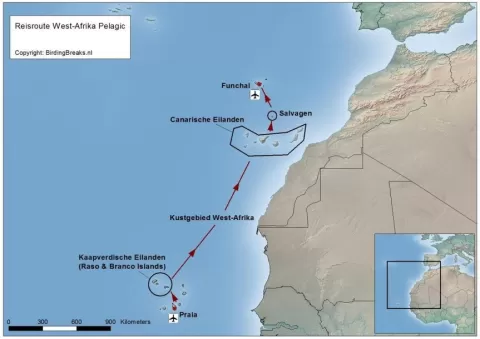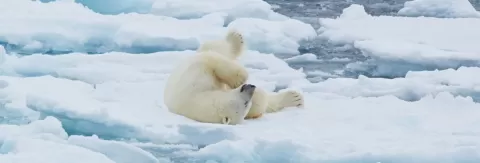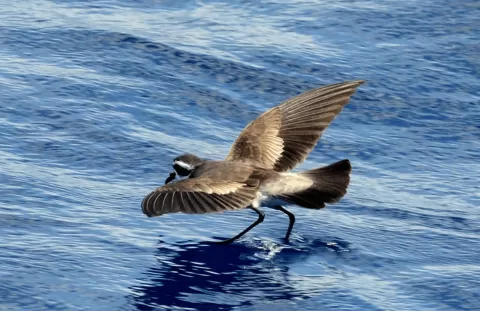Unique Expedition Cruise Along the West African Coast
Unique Expedition Cruise Along the West African Coast
Tour Organised by BirdingBreaks
May 4-12, 2026 | 09 Days | EUR 2450
All Slots Booked
Praia |
Around Raso – towards the West African continental shelf |
At sea |
Sailing along the upwellings of the West African coast |
La Gomera, Canary Islands |
Selvagen Islands |
Desertas Islands |
At sea north of Madeira and arrival Funchal |
Description
Pre- and post-tour have been fully booked
From Cape Verde, via the West African coast and the Canary Islands, to Madeira
For the first time in 10 years (since 2016), the West Africa Pelagic is back on sale for 2026! Sailing from Cape Verde to Madeira, this fantastic tour is a must for all seabird and wildlife enthusiasts. We visit the rich Cape Verde waters with birds such as Red-billed Tropicbird, Brown Booby, Cape Verde Shearwater, Boyd's Shearwater, Gon-gon, Bulwer's Storm Petrel, plus Pied and Cape Verde Storm Petrels. There's also a chance to see a Red-footed Booby and even a White-tailed Tropicbird, one of the first birds seen on the inaugural voyage in 2011!
The Cape Verde Islands lie 375 miles off the coast of West Africa and are all volcanic in origin. The islands offer diverse landscapes, from the spectacular rugged mountains of Santiago, Santo Antao, and Sâo Nicolau to the flat salt pans of Sal and Maio. The Cape Verde Islands were "discovered" by the Portuguese between 1455 and 1461. An interesting history of the Cape Verde Islands can be found in the museum in the center of Praia. The isolated location of the Cape Verde Islands has led to a number of endemic bird species and subspecies, such as the Bourne's Heron, Cape Verde Buzzard, Cape Verde Swift, Raso Lark, Cape Verde Warbler, and Cape Verde Sparrow. But there are also other interesting species such as the Courser, Grey-headed Kingfisher, White-banded Lark, Rufous-tailed Lark, Black-headed Finch Lark, and Spectacled Warbler. In addition, vagrants such as the Yellow-billed Heron, Black Heron, and African Pygmy Cormorant can sometimes be found. Another interesting point is that Charles Darwin landed on Santiago (recorded in his journal as St. Jago) on January 16, 1832, and noticed a layer of white shells on a cliff face near Porto Praya. This observation later led to one of his lesser-known theories about "rising continents" and "sinking ocean floors."
West Africa Pelagic, from Cape Verde to Madeira along the West African coast
For the first time in 10 years (since 2016), the West Africa Pelagic is on offer again for 2026! Sailing from the Cape Verde Islands to Madeira, this great tour is a real must for all seabird and wildlife enthusiasts. We will visit the rich Cape Verde waters with birds like Red-billed Tropicbird, Brown Booby, Cape Verde Shearwater, Boyd's Shearwater, Fea's and Bulwer's Petrels, plus White-faced and Cape Verde Storm Petrels. There might also be chances for Red-footed Booby and even White-tailed Tropicbird, which was one of the first birds seen on the inaugural voyage in 2011.
The Cape Verde Islands lie 375 miles off the coast of West Africa and are all volcanic in origin. The islands display a variety of landscapes from the spectacular rugged mountains of Santiago, Santo Antao, and Sâo Nicolau to the flat salt pans of Sal and Maio. The Cape Verde Islands were 'discovered' by the Portuguese between 1455 and 1461. An interesting account of the history of the Cape Verde can be found in the museum in central Praia. The isolation of the Cape Verde islands has resulted in a number of endemic (sub)species, particularly of birds, including Bourne's Heron, Cape Verde Buzzard, Cape Verde Swift, Raso Lark, Cape Verde Warbler, and Cape Verde Sparrow. But there are other interesting species too, like Cream-coloured Courser, Grey-headed Kingfisher, Hoopoe Lark, Bar-tailed Desert Lark, Black-crowned Finch Lark, and Spectacled Warbler. Another point of interest for naturalists is that on 16th January 1832, Charles Darwin landed on Santiago (recorded as St. Jago in his diary) and noted a layer of white shells in a cliff face at Porto Praya. An observation which later led to one of his less well-known theories of 'raising continents' and 'sinking ocean floors'.
- Itinerary
From Praia, we sail along the west coast of Santiago and north to the small island of Raso, about 120 miles from Santiago. There's much to enjoy along the way, especially in the evenings when the shearwaters and other seabirds return to the islands after a day of foraging at sea.
We'll take a Zodiac cruise near Raso to find Raso Larks and breeding seabirds before sailing to the West African coast for a migration spectacle! Here, in the rich waters along the coast of Mauritania and the Western Sahara, we can expect the unexpected. Thousands of birds are migrating north, including all four skua species. Flocks of Red Phalaropes are also common here, along with migrating Sabine's Gulls, European Storm Petrels, Northern Gannets, Arctic Terns, and Black Terns. These northern breeders are joined from the south by African Royal Terns, Wilson's Storm Petrels, plus Sooty Shearwaters and-for the lucky ones-perhaps even a South Polar Skua, a species recently documented to migrate north to these waters during our spring and summer months.
We then sail through the Canary Islands, where we look out for Barolo and Kuhl's Shearwaters, Bulwer's Storm Petrels, and Pied Storm Petrels.
The Selvagen Islands, lying 80 miles north of the Canaries, are perhaps the ultimate destination for anyone interested in the Western Palearctic "tubenoses." Huge numbers of petrels and shearwaters breed here, including approximately 15,000 Kuhl's Shearwaters, 5,000 Bulwer's Shearwaters, 2,000 Barolo's Shearwaters, 60,000 Pied Storm Petrels, and 1,500 pairs of Madeira Storm Petrels. Because many of these species gather offshore in the evenings before returning to their nesting grounds under cover of darkness, our evening cruise here should be one of the ornithological highlights of the trip.
The journey continues to Madeira, where we will search for Desertas Storm Petrel, Kuhl's Shearwater, Bulwer's Storm Petrel, and Madeira Storm Petrel, all of which breed on Desertas Island. The next morning, we visit the waters north of Madeira where the Freira (endemic to Madeira) feeds and where we may also encounter Barolo's Shearwater and Pied Storm Petrel. Around noon, we arrive in Funchal, the capital of Madeira, where you'll disembark from the MV Plancius. There's an option for a post-tour program to explore Madeira's specialties and visit the Freira Colony at night-a magical experience!
- Tour summary WEST AFRICA PELAGIC
From Praia we will cruise along the west coast of Santiago and north towards the small island of Raso, approximately 120 miles from Santiago, There will be plenty to enjoy en route, especially in the evening when the shearwaters and other seabirds begin to return to the islands after a day feeding out at sea.
We will make a zodiac cruise close to Raso to find Raso Lark and breeding seabirds before sailing to the West African coast for some migration spectacle! Here, in the rich waters along the shelf edge off Mauritania and Western Sahara, we might expect the unexpected. 1000's of birds will be migrating north, including all 4 skua species. Groups of Gray Phalaropes are also a common sight here, along with flocks of Sabine's Gulls, European Storm-petrel, Gannets, Arctic and Black Terns. These northern breeders are joined from the south by African Royal Terns, Wilson's Storm-petrels, plus Sooty Shearwater and - for the fortunate - perhaps even South Polar Skua; a species recently shown to head north into these waters during our spring and summer months. We will then sail through the Canary Islands where we will look out for Barolo's and Cory's Shearwaters, Bulwer's Petrels and White-faced Storm-Petrels.
The Selvagen islands, which lie 80 miles north of the Canaries, are perhaps the ultimate destination for anyone interested in
Western Palaearctic 'tube-noses'. Huge numbers of petrels and shearwaters breed here including approximately 15,000
Cory's Shearwaters, 5,000 Bulwer's Petrels, 2,000 Barolo's Shearwater, 60,000 White-faced Storm-petrels and 1,500 pairs of
Madeira Storm-petrels. Since many of these species gather off shore in the evening before returning to their nest sites after
dark, our evening cruise here should be one of the ornithological highlights of this holiday.
The tour continues to Madeira where we will search for Desertas Petrel, Cory's Shearwater, Bulwer's Petrel and Madeira Storm Petrel which all breed on Desertas Island. Next morning, we will visit the water north of Madeira where Zino's Petrel (endemic for Madeira) is known to forage and where we can also encounter Barolo's Shearwater and White-faced Storm Petrel.Around midday we will arrive in Funchal, the capital of Madeira, where you will disembark the MV Plancius. There is an option of doing a post-tour program to see the Madeiran specialties and to visit Zino's colony at night, a truly magical experience!
Detail Itinerary
- 4 May 2026: Praia
In Praia, we board the MV Plancius at 4:00 PM. Praia is located on the southern island of Santiago, one of the largest of the 10 islands (plus 8 islets) that make up the Cape Verde archipelago. From Praia, we cruise along the west coast of Santiago and north towards the small island of Razo, about 200 km from Santiago. A journey that will take the rest of the day and much of the night. However, we will sail through important seabird and whale watching waters and have plenty to see along the way, especially in the evening when the shearwaters and other seabirds return to the islands after a day at sea. With the volcanic Mount Fogo to our port side and flying fish darting across the water in front of us, we will be on the lookout for Cape Verde Shearwaters, Cape Verde Little Shearwaters, Gon-gon, and Bulwer's Petrels. These waters are also home to an exciting variety of whales, including Pilot Whale, Bottlenose Dolphin, Common Dolphin and perhaps even the Pantropical Spotted Dolphin and Sperm Whale.
In Praia passengers embark MV Plancius at 4:00 PM. Praia is located on the southern island of Santiago, one of the largest of the 10 islands (plus 8 islets) that make up the Cape Verde archipelago. From Praia we cruise along the west coast of Santiago and north towards the small island of Raso, approximately 120 miles from Santiago, a journey that will take the rest of the day and much of the night. We will, however, be crossing prime seabird and cetacean waters and there will be plenty to enjoy en route, especially in the evening when the shearwaters and other seabirds begin to return to the islands after a day feeding out at sea. With the volcanic cone of Fogo off to our port side and flying fish scuttling over the waters surface in front of our ship, we will be looking out for the Cape Verde Shearwater plus Boyd's Shearwater, Fea's Petrel and Bulwer's Petrel. These waters are also home to an exciting variety of cetaceans including Short-finned Pilot Whale, Bottlenose Dolphin, Common Dolphin and perhaps Pan-tropical Spotted Dolphin and Sperm Whale.- 5 May 2026: Around Raso – towards the West African continental shelf
We will spend this morning circumnavigating the small rugged island of Raso, located in the northwest of the archipelago between the larger islands of Sao Nicolau and Sâo Vicente. Cape Verde Shearwaters are common here and nest in large numbers on the island along with Boyd's Shearwater and both Cape Verde and White-faced Storm Petrels. Locating one of the endemic Raso Larks from the zodiacs has been proven to be a good possibility. Other targets this morning are the beautiful and graceful Red-billed Tropicbird which also nest on Raso plus Red-footed Booby, which is seen here regularly recently. Brown Boobies are another key species frequently seen around the islands. Mid-day we head northeast, away from the Cape Verde Islands and towards the continental shelf of West Africa. There will be plenty of commoner seabirds to enjoy, plus and opportunities to look for dolphins, pilot whales and perhaps some of the larger cetacean species.
We will spend this morning circumnavigating the small rugged island of Raso, located in the northwest of the archipelago between the larger islands of Sao Nicolau and Sâo Vicente. Cape Verde Shearwaters are common here and nest in large numbers on the island along with Boyd's Shearwater and both Cape Verde and White-faced Storm Petrels. Locating one of the endemic Raso Larks from the zodiacs has been proven to be a good possibility. Other targets this morning are the beautiful and graceful Red-billed Tropicbird which also nest on Raso plus Red-footed Booby, which is seen here regularly recently. Brown Boobies are another key species frequently seen around the islands. Mid-day we head northeast, away from the Cape Verde Islands and towards the continental shelf of West Africa. There will be plenty of commoner seabirds to enjoy, plus and opportunities to look for dolphins, pilot whales and perhaps some of the larger cetacean species.- 6 May 2026: At sea
Today we'll sail primarily over deep water from the Cape Verde Islands to the edge of the West African continental shelf off the coast of Mauritania. Seabirds and whales will dominate the day, and we hope for an interesting selection of seabirds as we head east
- 7 & 8 May 2026: Sailing along the upwellings of the West African coast
We'll reach the continental shelf near Nouadihbou in the morning and will sail north for two days along the shelf's edge (the so-called "upwellings") off the coast of Mauritania and Western Sahara. Here, we can expect the unexpected, as these rich waters are rarely visited by nature lovers. We hope to enjoy close-up views of common species along our route, plus a few surprises! All four northern skua species—Greater, Arctic, Pochard, and Long-tailed Skua—should be common. We have a chance of spotting Red Phalaropes and a migration of Sabine's Gulls, all now in summer plumage. Astern, we'll be watching for European Storm Petrels, Arctic Terns, and Black Terns. These northern breeders will be joined from the south by Wilson's Storm Petrels, plus Sooty Shearwaters and—for the lucky ones—perhaps even a South Polar Skua, a species that sometimes migrates north into these waters during our spring and summer months. One of the rarer seabirds that breed in the Macaronesian Islands is possible, along with an exciting array of whales, including fin whales, sperm whales, bottlenose dolphins, common dolphins, and perhaps even rarer species such as beaked whales and pygmy sperm whales. Other pelagic creatures to look out for include sunfish and even the occasional sea turtle.
We reach the shelf in the morning near Nouadihbou and will spend two days cruising north along the shelf edge off Mauritania and the Western Sahara. Here, we should expect the unexpected, as these rich waters are rarely visited by naturalists. We hope that at key points along our route, we will enjoy close views of plenty of the more common species, plus we hope for a few surprises! All four species of Northern Skua—Great, Arctic, Long-tailed, and Pomeranian—are common. Groups of Grey Phalaropes are also a common sight here, along with flocks of Sabine's Gulls, European Storm-petrels, Kittiwakes, and Black Terns. These northern breeders are joined from the south by Wilson's Storm-petrels, plus Sooty Shearwater and - for the fortunate - perhaps even South Polar Skua; a species recently shown to head north into these waters during our spring and summer months. Any of the rarer seabirds breeding on the Macaronesian Islands are possible, along with an exciting range of cetaceans which may include Fin Whale, Sperm Whale, Northern Bottlenose Whale, Cuvier's beaked Whale, Common Dolphin and the outside chance of rarer species such as Rough-toothed Dolphin, Blainville's Beaked Whale and Pygmy Sperm Whale. Other pelagic wildlife to look out for includes Sunfish and even the occasional turtle.- 9 May 2026: La Gomera, Canary Islands
We will explore the deep waters around La Gomera in the Canary Islands, a well-known hotspot for whales and dolphins. The inaugural 2011 voyage saw sperm whales and pilot whales, plus a number of dolphins, including the rough-toothed dolphin (the official Dutch name for rough-toothed dolphin). We will now be in range of Little Shearwaters, and we can also expect to see more Sooty Shearwaters, Bulwer's Petrels, and Pied Storm-Petrels today.
We will explore the deepwater channels around Gomera in the Canary Islands, a known hot spot for whales and dolphins. The inaugural 2011 voyage saw sperm and short-finned pilot whales, plus a number of dolphins, including rough-toothed. We will now be in range of Barolo's Shearwater, another species split from Little Shearwater, and we should expect more Cory's Shearwaters, Bulwer's Petrels, and White-faced Storm-Petrels today too.
- 10 May 2026: Selvagen Islands
In the afternoon, we'll reach the remote Selvagen Islands, where we'll first see Selvagen Pequina and then sail around Selvagen Grande in the evening. These isolated islands, located 130 km north of the Canary Islands, are perhaps the ultimate destination for anyone interested in Western Palearctic "tubenoses." Huge numbers of petrels and shearwaters breed
here, including approximately 15,000 Kuhl's Shearwaters, 5,000 Bulwer's Storm Petrels, 2,000 Little Shearwaters, 60,000 Pied Storm Petrels, and 1,500 Madeira Storm Petrels. Since many of these species gather offshore in the evenings before returning to their nesting grounds after dark, our evening cruise here should be one of the ornithological highlights of this expedition cruise. If conditions
permit, we will launch the zodiacs for an evening zodiac cruise to enjoy the seabirds and whales up close.
In the afternoon we reach the remote Selvagens, where we first see Selvagen Pequina and where we will spend an evening cruising around Selvagen Grande. These isolated islands, which lie 80 miles north of the Canaries, are perhaps the ultimate destination for anyone interested in Western Palaearctic 'tube-noses'. Huge numbers of petrels and shearwaters breed here including approximately 15,000 Cory's Shearwaters, 5,000 Bulwer's Petrels, 2,000 Barolo's Shearwater, 60,000 White-faced Storm-petrels and 1,500 pairs of Madeira Storm-petrels. Since many of these species gather off shore in the evening before returning to their nest sites after dark, our evening cruise here should be one of the ornithological highlights of this holiday. If conditions permit we wilI launch the zodiacs for an evening zodiac cruise to enjoy the seabirds and cetaceans at close range.
- 11 May 2026: Desertas Islands
In the second half of the day, we'll sail past the Desertas Islands. The Desertas are part of the Madeira archipelago. In 1990, they became a nature reserve, encompassing the islands themselves and the surrounding sea down to a depth of 100 meters. The reserve is divided into two protected zones, with the southern half of Deserta Grande and Bugio strictly off-limits to visitors, even by boat. Deserta
Grande houses a permanent research station; the researchers are currently the only human inhabitants of the islands. The Desertas have been designated a Special Area of Conservation (SAC) due to their significant seabird populations. Kuhl's Shearwaters, Bulwer's Storm Petrels, and Madeira Storm Petrels all breed here, along with Desertas Storm Petrels. We'll have the chance to encounter an interesting selection of whales, including Common Dolphins, Bottlenose Dolphins, Pilot Whales, and perhaps a Fin Whale or an early Bryde's Whale. Sperm whales are most frequently sighted in these waters and spend most of the year feeding on squid from the deep
canyons surrounding the islands. A population of fewer than 100 Mediterranean monk seals also lives around the Desertas Islands.
In the second half of the day, we will sail alongside the Desertas Islands. The Desertas belong to the Madeira archipelago. In 1990, they became a Nature Reserve, encompassing the islands themselves and the surrounding sea to a depth of 100 meters. The reserve is divided into two protected zones, of which the southern half of Deserta Grande and Bugio are strictly forbidden to visitors, even by boat. On Deserta Grande, there is a permanent research station with three wardens, who are the only human inhabitants on the islands these days. The Desertas were designated a Special Protection Area for their important seabird populations. Cory's Shearwater, Bulwer's Petrel, and Madeira Storm Petrel all breed here along with the Desertas Petrel. We have a chance to observe an exciting selection of cetaceans including Common Dolphin, Bottle-nosed Dolphin, Short-finned Pilot Whale and perhaps a Fin or early Bryde's Whale. Sperm Whales are the most frequently seen large whales in these waters and spend most of the year feeding on squid from the deep water canyons and trenches that surround the islands. A population of less than 100 Mediterranean Monk Seals also live around the Desertas.
- 12 May 2026: At sea north of Madeira and arrival Funchal
In the morning, we'll be about 35 kilometers north of Madeira, in an area where the Zino's Petrel (endemic to Madeira) regularly
forages. We'll make a serious attempt to spot this special bird at sea. Around noon, we'll arrive in Funchal, the capital of Madeira, where we'll disembark from the MV Plancius. This marks the end of our wonderful adventure! There's an option to follow a post-tour program to see Madeiran specialties and visit the Zino's Petrel colony in the evening. This is a truly magical experience!
The morning will find us about 20 nautical miles north of Madeira, in an area where the Zino's Petrel (endemic to Madeira) is known to forage. Around midday, we'll arrive in Funchal, the capital of Madeira, where you'll disembark the MV Plancius. There's an option to follow a post-tour program to see Madeiran specialties and visit Zino's colony at night. This is a truly magical experience! From Funchal, you can take flights to your home destination (post-tour activities not included in the fare).
NB: The above programme may change on site due to weather conditions, recent information about certain bird species or organisational reasons.
Service Included
- All overnight stays on board
- All activities offered as indicated in the trip are free of charge
- All meals on board, incl. coffee, tea and snacks
- All Zodiac cruises
- All lectures and presentations on board given by the experienced expedition team
- Various port fees and taxes
- AECO surcharges and government taxes
Service Not Included
- International flights
- Pre- and post-trip arrangements on board
- Transfers to the ship in Praia
- Meals ashore
- Drinks, tips, and personal expenses
- The customary tip at the end of the trip for onboard staff (guidelines will be provided)
- Booking fee and guarantee fund contribution: EUR 20.00 for the first person; thereafter EUR 15.00 per person.
Extra
Pocket money for personal expenses
- Departure dates and prices
To register for a trip, go to the booking button for the relevant departure date. When booking, keep in mind our early bird discount and remember that some trips can fill up quickly, so book early.
If you prefer to fill out the booking form manually and send it by post, click !
Room layout
At BirdingBreaks, you can opt for a shared room. You will then be assigned to a double or triple room. If these are unavailable, you will be assigned to a single room (subject to availability). In that case, BirdingBreaks.nl will cover 50% of the cost of the single room.Cabin price per person (EUR) Quadruple 2450,- Twin porthole 3050.- Twin window 3350,- Twin de luxe 3800,- Superior 4350,-
Booking costs and VZR Garant
The following Booking costs and VZR Garant contribution are charged per booking:
For 1 person: EUR 20.00
For 2 persons: EUR 35.00
For 3 persons: EUR 50.00
For 4 persons: EUR 65.00
If the total amount of the travel sum is higher than EUR 12,500, BirdingBreaks.nl applies the following scale:
For bookings from EUR 12,500 to EUR 25,000: an additional surcharge of EUR 7.50 per person
For bookings from EUR 25,000 to EUR 37,500: an additional surcharge of EUR 15.00 per person
For bookings from EUR 37,500 to EUR 50,000: an additional surcharge of EUR 22.50 per person
Option
If you're still unsure or need to discuss your options before booking, feel free to take a no-obligation option on this trip! If the trip departs within 8 weeks, an option is valid for 24 hours. If the trip departs after 8 weeks, it's valid for 7 days. During the option period, BirdingBreaks will hold your spot for you, as long as there's availability. If the trip fills up sooner, we'll contact you by phone or email. Once the option expires, no rights can be derived from it.
STAND FOR TREES
All CO2 emissions from group trips are offset by BirdingBreaks through Stand for Trees.- Climate
The voyage will generally be warm and sunny, but the wind can make it feel cooler at sea, especially in the mornings and evenings. Expect variable weather conditions in Madeira, with slightly lower temperatures in the mountains.
- Gravity
An average level of fitness is required for boarding and disembarking the zodiacs. Some light walking on land is required.- Tour guide
Instructions at each location are provided on board by the English-speaking expedition leader, supported by several guides. In some cases, the crew also speaks other languages. The expedition leaders are all experts in the areas visited and are always available for questions or assistance with the sometimes difficult identification of species such as seabirds.
In addition to the expedition leader and guides, the ship's crew includes nautical crew members, hotel staff, cooks, and a doctor- Flight
This expedition cruise departs from Praia (Cape Verde) and ends in Funchal (Madeira). International flights are not included.Flight Proposal:
If you would like a quote for international flights, please indicate this in the booking form. We will then contact you to discuss the options. Reserved flights require a 100% deposit.- Booking And Cancellation Policy
